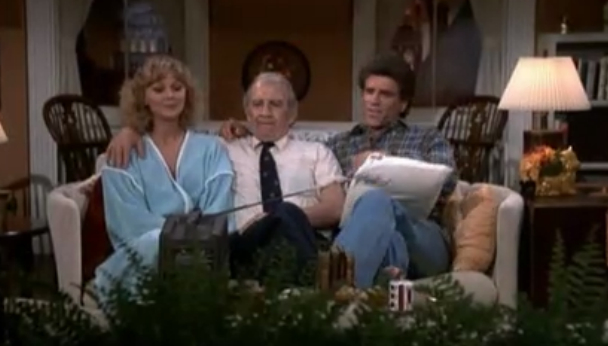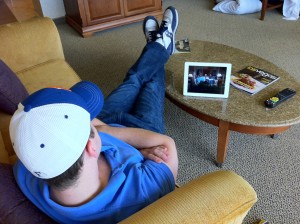
Yesterday night, I busted from a tournament at the Wynn (I min-cashed), but decided to stick around because a friend was still playing and I wanted to offer support (known as sweating or railing in the poker parlance). Fortunately, I had my Burro Bag with me, and the Burro Bag holds many ways to kill time: Books, iPad, Macbook. I usually read when I’m just sitting around, sweating a tournament, but I decided to watch TV instead.
The iPad came out, and I watched the final episode of This American Life Season 1 on Netflix, then watched an episode of Cheers (I’m mid way through Season 2), then switched over to the HBO GO app to see what I could find there. I decided to watch a documentary called “Hot Coffee” (a good documentary about tort reform, our litigious society, etc.) from their series of documentaries that’s airing every Monday night.
As I was watching that episode of Cheers, it hit me: I’m watching HD TV on a portable device that’s smaller than a Dr. Seuss book. There’s a scene in the episode (Coachie Makes Three) where Sam and Diane finish eating dinner, then Sam decides to watch some TV. So he pulls out this big, clunky portable TV that plugs into the wall. I’m guessing the screen on it was something like 7″. He plugs it in, plunks it down on the coffee table and kicks back on the couch to “check some scores out on the tube”. Of course, then Coach shows up because “Thunder Road” is on TV, and Sam and coach never miss Robert Mitchum when he’s on TV.
That’s when it hit me that I could do that now, only I don’t have to plug it in, I’m watching HD TV, and I can choose from a giant catalog of shows whenever I want rather than choosing between the five or six channels Sam probably got in 1984. Today, it’s not a problem if I miss something when it first airs – I can always just go watch it online later. It sort of blew my mind a little, and I saw this coming in 2009. Sort of.
In 2009, I definitely expected Apple to make the iPad. I also expected it to be used a lot as a portable media player. But I envisioned people mostly loading up movies and TV shows into iTunes, syncing the iPad and then taking it with them. I didn’t think we’d be streaming HD TV OTA less than two years later. Yes, I was using the Wynn’s WiFi network (which is hi-speed and free to anyone at the Wynn), but when I went back to my room at the Rio a little later, I continued watching “Hot Coffee” tethered to my iPhone 4, over 3G. If I weren’t so cheap, I could’ve cut out the middle man and just bought the 3G iPad, which would let me stream directly to the device without an iPhone. What?!
Ten years ago, it was a big deal to check email on a cell phone. Eight years ago, it was a big deal when ESPN Motion was “streaming” highlights on ESPN.com. (That’s where I first saw streaming video online.) Six years ago, it was a big deal to stream low-quality video on YouTube. Three years ago, it was a big deal when Netflix and Starz teamed up to start offering streaming movies, on demand. But all this required some kind of PC with an internet connection.
Up to this point, there were ways to stream video over the air, but they were tricky, unreliable and definitely not mainstream. Then, about a year ago, Netflix came out with an iPhone and iPad app that would let subscribers stream content over 3G. No more land-based internet connection required. Not only that, but (assuming the 3G connection was solid), it was high quality video. Over 3G.
The rate of innovation is stunningly fast to me. When I first saw ESPN Motion, I thought, “This is awesome, but how will they eventually stream real content? Live content? Decent quality video?” I thought it was a very big technical challenge because video was just so data intensive, and streaming audio over the internet was still pretty new. Compressed audio (MP3s) would stream, but it was a little unstable and required patience. Video took up much more bandwidth than audio, and I didn’t see how the tubes would get fat enough to squeeze that much data into a connection.
It was a significant technical challenge, but what I didn’t anticipate was a convergence of technologies: faster, more efficient internet connectivity and better and better compression and buffering algorithms for streaming video. I’m still not actually sure how video is compressed and high quality. But some engineers figured it out and instead of waiting for the bandwidth to catch up with the data requirements, we managed to simultaneously increase bandwidth and reduce data requirements by compressing video.
And now I can sit around anywhere watching TV on my iPad to kill time while my friend wins a tournament. Pretty cool, right?


